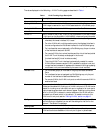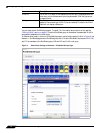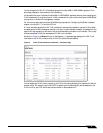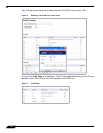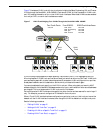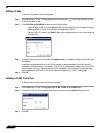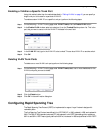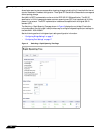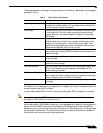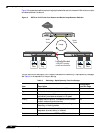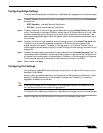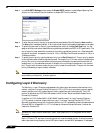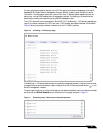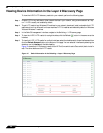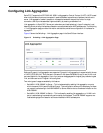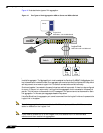
Configuring Switching
15
SonicOS 5.7: Advanced Switching Feature Guide and Screencast Tutorial
The settings displayed in the Bridge Information section of the Switching > Rapid Spanning Tree page are
described in Table 2.
Table 2 RSTP Configurable Objects
Auto detection of non-edge ports is not supported. A non-edge port is one that is connected directly to an
end-user computer such as a PC or laptop.
You can enable/disable RSTP on VLAN trunk ports only. By default, RSTP is disabled on trunk ports.
Note You should enable the RSTP before performing physical network connectivity between the
SonicWALL NSA 2400MX and another switch.
When the SonicWALL NSA 2400MX is booting up, ports are disabled until Spanning Tree configuration is
applied. The NSA 2400MX automatically soft-bridges the STP Bridge Protocol Data Units (BPDUs)
between the ports to prevent loops when ports in the same VLAN (PortShield group or L2 Bridge mode)
are connected to another switch. This allows the remote switch to detect that its ports are connected to
another switch and it can automatically block certain ports.
Item Description
Root Bridge ID The root bridge ID is an 8-byte value with 2 bytes for the bridge priority
and 6 bytes for the MAC address. The root bridge has the lowest value for
priority among all switches in the network.
Root Bridge Indicates whether or not the SonicWALL NSA 2400MX is the root bridge
in the bridged LAN. The root bridge is chosen by an election process
among all switches in the network, based on bridge priority and bridge
MAC address.
Root Priority Bridge priority is configurable in multiples of 4,096 with a default value of
32,768 and maximum of 61,440. Lower numbers indicate higher priority.
Bridge priority is the key factor in determining the root bridge. It also
determines the designated bridge for each LAN segment when multiple
bridges have the same path cost to the root bridge.
Root Path Cost The root path cost is based on the speed of the interface that connects to
the root bridge, and is used by RSTP to calculate the shortest path to the
elected root bridge.
Root Port The root port is the interface on a bridge that provides the shortest path
to the root bridge.
Root Age Time (sec) The root age time is the number of seconds since the last hello packet
arrived from the root bridge.
Root Max Age (sec) The root max age is the time interval without sending a hello packet after
which a switch is assumed to be unreachable and the Spanning Tree
network topology is updated.
Root Forward Delay (sec) The root forward delay is the time allowed for the listening and learning
state. It is also the time that it takes to convert an interface from a blocking
state to a forwarding state. The default is 15 seconds.
Root Hello Time The root hello time is the time interval between hello packets sent to the
root bridge.



